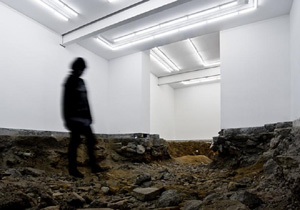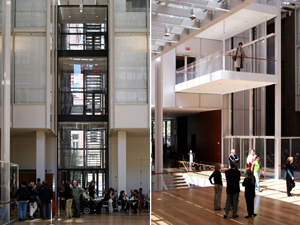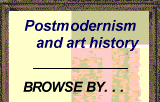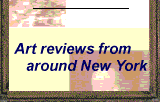Boom, Bust, and Renewal
John Haberin New York City
Has the Art Market Run Its Course?
If you stayed with me last week, you know what I am thinking these days, stuck indoors with an injury and too little else on my mind: should I cut back sharply, even as I regain full mobility? Have I simply run out of things to say?
Then, too, has art itself run out of things to say? And no, for once I am not talking about the "anything goes" spirit in painting, with old stories and familiar brushwork to match. Eclecticism has its rewards, after all, especially when it means discarding old divisions between the personal and the political, mythmaking and making art. Especially, too, when it translates into diversity, with more room for nonwhites and women. Rather, I mean lassitude on the business side, as galleries find it harder and harder to survive. I have given up counting just how many went under that seemed like permanent fixtures and how many dealers saw 2024 as a good time to retire. 
Paying for it
Not that the two issues, what to say and how to pay for it, are unconnected. Quite the contrary. When art turns to new ideas and new energy, artists and collectors alike rush to share in the possibilities. It happened with Abstract Expressionism, and galleries are still turning up forgotten painters and neglected sculptors—or convinced that they should. It happened again with the millennium, when this Web site was still young. I set out with the belief that painting was not at all dead, thank you, and art history still matters. I was rewarded with a gallery boom, museum growth, and larger audiences for both.
Not that the boom is over yet either. The expanded Frick Collection reopens to high praise this very month, with the New Museum, the Studio Museum in Harlem, and the Princeton University art museum on their way. And, however many have gone under, dealers trying. Who would have imagined the clean lines of a full building in Chinatown for Magenta Plains, the sprawl across Chelsea and Tribeca for David Zwirner, or seven stories for Pace gallery, with another branch just up the street—or the nonstop art fairs? And yet the losses are inescapable. More to the point, what if loss is the new normal?
Art has a way of renewing itself in the face of failure, because that pretty much defines the making of art. I my own writing a single painting each by Jan Vermeer, Jan van Eyck, and Giovanni Bellini because I could not get them out of mind. I started, too, with the first signs of a shift in galleries from Soho to Chelsea. I followed galleries to Williamsburg, Dumbo, and Bushwick—and watched them die. A gallery scene leads to gentrification, but art moves on. Can a shrinking Lower East Side and the new concentration of galleries in Tribeca fare otherwise?
Regardless, I can always learn something each step of the way—and not just from the dozens of niche art markets that remain. With Asian art alone, last year brought me face to face with calligraphy, mandalas, aboriginal art, heaven and hell, and the hell we are creating a climate of coal and ice. Buddhism aside, though, what if there is more to the story than cycles of renewal? What if thirty years of growth were the exception all along? What if attrition remains when the stars of the show pass? What is left at the end of the day?
Part is sheer economics. The cheap rents that brought past spurts (and allowed me to get by) are not coming back. Collectors have proved difficult to lure too far downtown or out of Manhattan. You know the old lines that the market can stay irrational longer than you can wait? As Dumbo proved, real estate interests can hold onto vacant property longer than you can afford it. Art develops in an agonizing parallel to inequality in a market economy as a whole, as the wealthy take up more space and more spaces, like art worlds all to themselves.
To see what that means for the future, it helps to look back. Yes, I followed the cycle of boom and bust for thirty years, with the emphasis on the boom. And yes, I watched as a hurricane closed Chelsea and recessions took their toll. I watched, too, as Covid-19 shuttered museums, galleries, and art fairs entirely. But that still leaves the perils of business as usual, and I do mean business. Consider, then, an alternative history of contemporary art.
Luncheon off the grass
In 2009, at the very height of the boom, Edward Winkleman released How to Start and Run a Commercial Art Gallery, and he if anyone should know how. A Williamsburg pioneer, he brought his gallery to Chelsea, expanding the action a block to the west along with three more of the most adventurous out there. He also started an art fair devoted entirely to high-tech, interactive art, including my very first experience with virtual reality. Still, for all its sane advice, it takes something for granted: you or anyone else really can start and run a commercial gallery—and you are dying to try. Oh, and did I mention that Ed's gallery is long gone?
Just to speak about what comes next after the pandemic has its own hidden assumptions as well. It takes for granted that art really is coming back, and it assigns blame for the losses to a virus. What, though, if the boom needs explaining in the first place? Yes, artists can make their own scene, and ideas matter, but that cannot be the whole story. Great movements in the past had their champions like Gertrude Stein, Lillie P. Bliss, and Petty Guggenheim, but not entire neighborhoods.  And only the last of those three was a dealer.
And only the last of those three was a dealer.
Look back at HaberArts. I started with the art of museums, because I had years reading and seeing in my head. Besides, galleries did not take anywhere near as long to describe, as Minimalism and conceptual art lingered on. I summed them up with twice a year "gallery tours," continuing for over a decade. I knew that something was changing, but what? Who knew that art today would treat discoveries then like old masters, with still life to match?
I took new arts districts as a pleasure, but the onset of big money as a threat. I wrote of what Jerry Saltz (now more of a cheerleader, I am afraid) called the "battle for Babylon." I distrusted exhibitions as paybacks to donors and collectors. I hated that as fine an architect as Renzo Piano devoted expansion of the Morgan Library to a cafeteria. Already, Yoshio Taniguchi had used expansion at MoMA for a block-long lobby and an unworkable atrium. Did anyone still care about art?
In fact they did then, and they do—and it had a great deal to do with change. New audiences were transforming art into a popular art form. In turn, dealers and museum directors saw not just an opportunity, but a duty. Museums added education centers and no end of wall text. If people also require food to get them through the day, who am I to complain? Lines for the old-world cafeteria at Neue Galerie exceed those for the museum, and the Frick now has its first.
In short, there is no going back. Does that make this the bust to end all busts? Not necessarily, and I cannot predict the outcome of Donald J. Trump's disturbing economics, but this history shifts debate from the roots of change to how the arts address it. The growth of inequality is real, but critics, artists, and institutions can see it as more than an end in itself. They can hope for crowds while resisting the allure of big money and mass entertainment. Meanwhile I just hope that the Jewish Museum brings back its black-and-white cookies.




